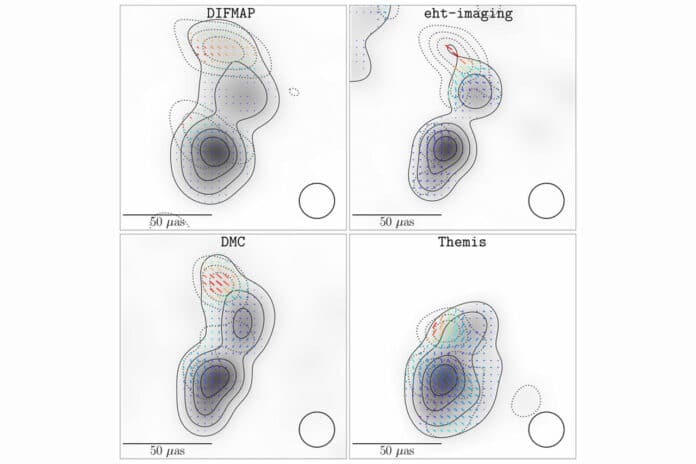In the nuclei of far-off galaxies, quasars are potent radiation sources. Supermassive black holes serve as their primary propulsion systems, accelerating radiation and particles into thin, brilliant jets. Astronomers are attempting to comprehend the complex physics of these cosmic monsters. They need help figuring out how the jets are precisely fuelled and formed and what function magnetic fields play in their production.
A global collaboration of scientists used the Earth-size virtual radio telescope, the Event Horizon Telescope (EHT), to peer into the heart of a distant quasar NRAO 530. Thanks to the extremely high, unprecedented angular resolution of EHT, astronomers could image the previously unseen structures in the central region of NRAO 530.
The EHT collaboration uses various imaging methods to establish certainty regarding an object’s structure on fine scales that are opaque at larger wavelengths. There are several of them, including brand-new techniques explicitly created for high-frequency Very Long Baseline Interferometry (VLBI) imaging, et-imaging, SMILI, DMC, and Themis, as well as the conventional VLBI technique CLEAN.
The figure shows images of the quasar NRAO 530 obtained by different methods in total and polarized light. The images reveal a bright feature located on the southern end of the jet, which the authors associate with the VLBI core at millimeter wavelengths.
The core of quasars like NRAO 530 manifests as the location where the jet begins at a specific wavelength. The jet extends over the distance that light crosses in ~1.7 years in projection on the sky plane. It includes two features with orthogonal polarization directions (electric vector position angle), parallel and perpendicular to the jet axis, consistent with a helical structure of the magnetic field in the jet.
According to scientists, it indicates a helical structure of the magnetic field in the jet.
Dr. Svetlana Jorstad, a senior scientist at Boston University, USA, who leads the NRAO 530 project, said, “The outermost feature has a particularly high degree of linear polarization, suggestive of a very well-ordered magnetic field.”
Dr. Maciek Wielgus, a scientist at the Max Planck Institute for Radio Astronomy in Bonn, Germany, co-leading this study, said, “It’s also the most distant object that we have imaged with the EHT so far. The light that we see traveled towards the Earth for 7.5 billion years through the expanding Universe, but with the power of the EHT, we see the details of the source structure on a scale as small as a single light-year.”
The EHT collaboration looks forward to future observations of the quasar to understand how the innermost jet features and their connection to the production of high energy photons change over time since NRAO 530 is a well-known source of powerful gamma rays.
Journal Reference:
- S. Jorstad, M. Wielgus, et al. +EHTC: “The Event Horizon Telescope Image of the Quasar NRAO 530”, in Astrophysical Journal ApJ 943 170 (2023). DOI: 10.3847/1538-4357/acaea8
